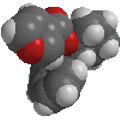 |
Chapter 1:
Structure Determines Properties |
 |
VSEPR - Predicting the
Shapes of Molecules
Looking first at simple molecules, where a
central atom is surrounded
by two or more other atoms, there are only six unique
electronic
geometries that an organic chemist needs to be readily familiar
with.
The electronic geometry is determined by how many bonding and
non-bonding
electron groups surround a central atom.
For each electronic geometry, there may be
a number of different molecular
geometries (the shape of a molecule when only bonded atoms are
considered).
Representations are given below, manipulate the molecular geometries
and
see how they relate to the parent electronic geometry.
Though not important when
determining the structure of most organic
compounds, the trigonal bipyramidal and octahedral geometries are
important when considering transition states during SN2
mechanisms
or the geometry about transition metals in reagents or proteins.
| Electronic
Geometry |
Molecular Geometries
|
|
|
|
|
|
|
|
|
|
BF3
|
SO2
|
|
Trigonal planar
|
Bent
|
|
|
|
|
|
|
|
|
CH4
|
NH3
|
H2S
|
|
Tetrahedral
|
Trigonal pyramidal
|
Bent
|
|
|
|
|
|
|
|
|
|
PF5
|
TeCl4
|
BrF3
|
XeF2
|
|
Trigonal bipyramidal
|
See-saw
|
T-shaped
|
Linear
|
|
|
|
|
|
|
|
|
SF6
|
IF5
|
XeF4
|
|
Octahedral
|
Square pyramidal
|
Square planar
|
|
 |
© Dr. Ian Hunt,
Department of Chemistry, University of Calgary |
 |

